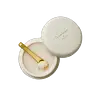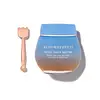What's inside
What's inside
 Key Ingredients
Key Ingredients

 Benefits
Benefits

 Concerns
Concerns

 Ingredients Side-by-side
Ingredients Side-by-side

Polyglyceryl-2 Triisostearate
EmulsifyingCaprylic/Capric Triglyceride
MaskingSqualane
EmollientMica
Cosmetic ColorantButyrospermum Parkii Oil
EmollientHelianthus Annuus Seed Wax
Skin ConditioningPhytosteryl/Octyldodecyl Lauroyl Glutamate
Skin ConditioningDimer Dilinoleyl Dimer Dilinoleate
EmollientSilica
AbrasiveOpuntia Ficus-Indica Seed Oil
EmollientDisteardimonium Hectorite
StabilisingEuphorbia Cerifera Wax
Ceramide NP
Skin ConditioningPalmitoyl Tripeptide-1
Skin ConditioningOpuntia Ficus-Indica Leaf Cell Extract
Skin ProtectingHibiscus Syriacus Callus Extract
AntioxidantRutin
AntioxidantSodium Hyaluronate
HumectantTocopherol
AntioxidantRosa Canina Fruit Oil
EmollientHydrolyzed Collagen
EmollientTribehenin
EmollientHelianthus Annuus Seed Oil
EmollientButylene Glycol
HumectantEthylhexyl Palmitate
EmollientSorbitan Isostearate
EmulsifyingPolyglyceryl-2 Triisostearate, Caprylic/Capric Triglyceride, Squalane, Mica, Butyrospermum Parkii Oil, Helianthus Annuus Seed Wax, Phytosteryl/Octyldodecyl Lauroyl Glutamate, Dimer Dilinoleyl Dimer Dilinoleate, Silica, Opuntia Ficus-Indica Seed Oil, Disteardimonium Hectorite, Euphorbia Cerifera Wax, Ceramide NP, Palmitoyl Tripeptide-1, Opuntia Ficus-Indica Leaf Cell Extract, Hibiscus Syriacus Callus Extract, Rutin, Sodium Hyaluronate, Tocopherol, Rosa Canina Fruit Oil, Hydrolyzed Collagen, Tribehenin, Helianthus Annuus Seed Oil, Butylene Glycol, Ethylhexyl Palmitate, Sorbitan Isostearate
Glycerin
HumectantPropanediol
SolventCaprylic/Capric Triglyceride
MaskingSodium Acrylates Copolymer
Hydrogenated Polyisobutene
EmollientWater
Skin ConditioningPanthenol
Skin ConditioningPhospholipids
Skin ConditioningLeuconostoc/Radish Root Ferment Filtrate
AntimicrobialHelianthus Annuus Seed Oil
EmollientPolyglyceryl-10 Stearate
Skin Conditioning3-O-Ethyl Ascorbic Acid
Skin ConditioningIsosorbide Dicaprylate
Skin ConditioningBenzyl Alcohol
PerfumingCocodimonium Hydroxypropyl Silk Amino Acids
Skin ConditioningMarrubium Vulgare Meristem Cell Culture
Skin ProtectingButylene Glycol
HumectantCaprylhydroxamic Acid
Hydrolyzed Verbascum Thapsus Flower
AntioxidantAvena Sativa Meristem Cell Extract
HumectantSodium Gluconate
Skin ConditioningSodium Lactate
BufferingRumex Occidentalis Extract
Skin ConditioningNonapeptide-1
Skin ConditioningDextran
Xanthan Gum
EmulsifyingSodium Hyaluronate
HumectantPhenethyl Alcohol
MaskingPotassium Sorbate
PreservativeCaprylyl Glycol
EmollientGlycerin, Propanediol, Caprylic/Capric Triglyceride, Sodium Acrylates Copolymer, Hydrogenated Polyisobutene, Water, Panthenol, Phospholipids, Leuconostoc/Radish Root Ferment Filtrate, Helianthus Annuus Seed Oil, Polyglyceryl-10 Stearate, 3-O-Ethyl Ascorbic Acid, Isosorbide Dicaprylate, Benzyl Alcohol, Cocodimonium Hydroxypropyl Silk Amino Acids, Marrubium Vulgare Meristem Cell Culture, Butylene Glycol, Caprylhydroxamic Acid, Hydrolyzed Verbascum Thapsus Flower, Avena Sativa Meristem Cell Extract, Sodium Gluconate, Sodium Lactate, Rumex Occidentalis Extract, Nonapeptide-1, Dextran, Xanthan Gum, Sodium Hyaluronate, Phenethyl Alcohol, Potassium Sorbate, Caprylyl Glycol
 Reviews
Reviews

Alternatives
Ingredients Explained
These ingredients are found in both products.
Ingredients higher up in an ingredient list are typically present in a larger amount.
Butylene Glycol (or BG) is used within cosmetic products for a few different reasons:
Overall, Butylene Glycol is a safe and well-rounded ingredient that works well with other ingredients.
Though this ingredient works well with most skin types, some people with sensitive skin may experience a reaction such as allergic rashes, closed comedones, or itchiness.
Learn more about Butylene GlycolThis ingredient is an emollient, solvent, and texture enhancer. It is considered a skin-softener by helping the skin prevent moisture loss.
It helps thicken a product's formula and makes it easier to spread by dissolving clumping compounds.
Caprylic Triglyceride is made by combining glycerin with coconut oil, forming a clear liquid.
While there is an assumption Caprylic Triglyceride can clog pores due to it being derived from coconut oil, there is no research supporting this.
Learn more about Caprylic/Capric TriglycerideHelianthus Annuus Seed Oil is the oil derived from the seeds of a Sunflower. Sunflower seed oil is non-fragrant. It is an emollient, meaning it helps to soften the skin.
Sunflower seed oil contains many fatty acids. The fatty acids found in sunflower seeds include (from highest amount to least): linoleic acid, myristic acid, palmitic acid, stearic acid, arachidic acid, oleic acid, and linolenic acid.
These fatty acids help the skin create ceramides. Ceramides play a role in repairing the skin barrier.
Helianthus Annuus Seed Oil helps moisturize the skin. This in turn helps the skin look more rejuvenated and smoother.
Sunflowers are rich in vitamin E.
Historians believe Indigenous cultures of North America domesticated sunflowers before corn. Thus they relied on sunflower oil for a variety of uses. One such use is moisturizing skin and hair.
Sunflower seed oil may not be fungal acne safe. We recommend speaking with a professional if you have any concerns.
Learn more about Helianthus Annuus Seed OilSodium Hyaluronate is hyaluronic acid's salt form. It is commonly derived from the sodium salt of hyaluronic acid.
Like hyaluronic acid, it is great at holding water and acts as a humectant. This makes it a great skin hydrating ingredient.
Sodium Hyaluronate is naturally occurring in our bodies and is mostly found in eye fluid and joints.
These are some other common types of Hyaluronic Acid:
Learn more about Sodium Hyaluronate